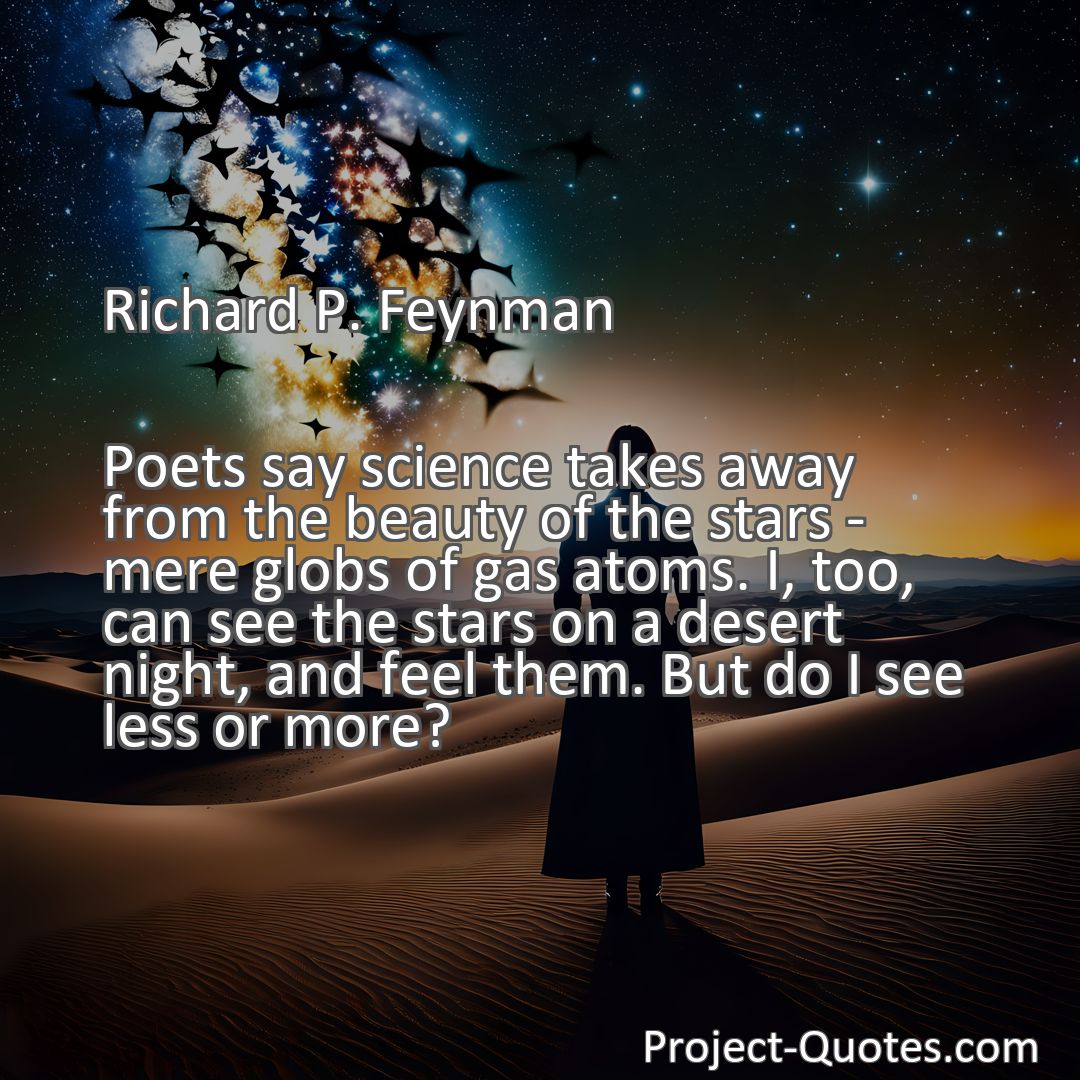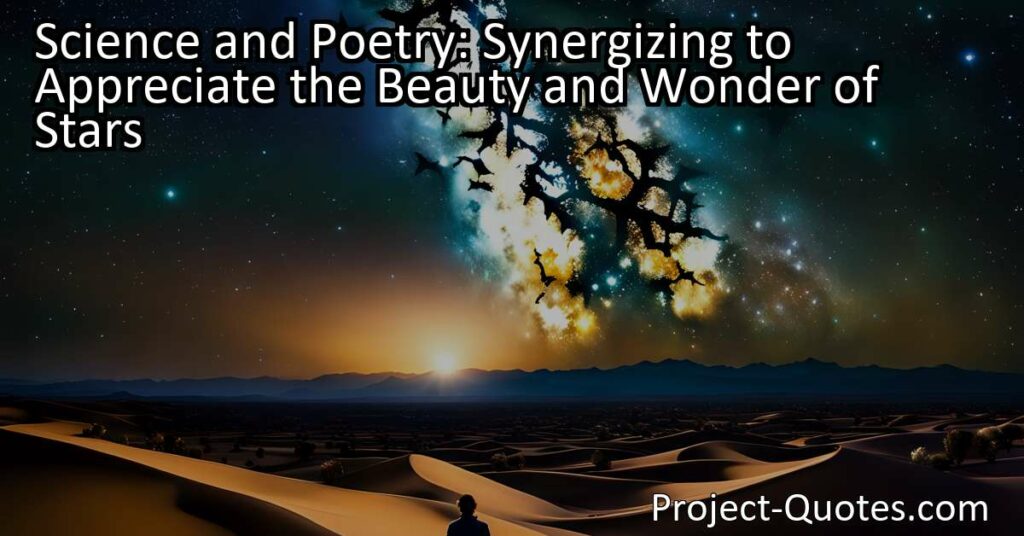Poets say science takes away from the beauty of the stars – mere globs of gas atoms. I, too, can see the stars on a desert night, and feel them. But do I see less or more?
Richard P. Feynman
Science and poetry come together to deepen our understanding and appreciation of the beauty and wonder of stars. Rather than diminishing their splendor, scientific knowledge enhances our sense of awe by revealing the intricate processes and interconnectedness of the universe. Embracing both the poetic and scientific perspectives allows us to fully appreciate the grandeur and complexity of the stars.
Table of Contents
- 1 Poets say science takes away from the beauty of the stars – mere globs of gas atoms. I, too, can see the stars on a desert night, and feel them. But do I see less or more?
- 2 Richard P. Feynman
- 3 Meaning of Quote – Poets say science takes away from the beauty of the stars – mere globs of gas atoms. I, too, can see the stars on a desert night, and feel them. But do I see less or more?
- 4 Freely Shareable Quote Image
- 5 Related
Meaning of Quote – Poets say science takes away from the beauty of the stars – mere globs of gas atoms. I, too, can see the stars on a desert night, and feel them. But do I see less or more?
In the vast expanse of the night sky, the stars twinkle and shimmer, captivating our imagination and filling us with a sense of wonder. It is a sight that has fascinated humanity for centuries, inspiring poets, artists, and dreamers alike. Yet, amidst this beauty and awe, a question arises – does the scientific understanding of stars detract from their inherent splendor or enhance our appreciation of them?
Some poets argue that science diminishes the beauty of the stars by reducing them to mere globs of gas atoms. They believe that unraveling the mysteries of the universe through scientific inquiry strips away the enchantment and mystery, leaving behind cold and lifeless explanations. While it is true that scientific knowledge can sometimes seem dry and detached from the realm of emotions, this perspective fails to acknowledge the profound connection between science and poetry.
Science, rather than diminishing the beauty of the stars, can serve as a powerful tool to deepen our understanding and appreciation of them. By studying the stars, scientists have illuminated the origins of the universe and the complex processes that govern the cosmos. They have deciphered the intricate dance of celestial bodies, from the birth of a star to the cataclysmic explosion of a supernova. Through their investigations, scientists have unlocked the secrets of the stars, revealing the incredible forces at play in the vastness of space.
But does this newfound knowledge diminish the sense of wonder and awe that the stars inspire? Not in the slightest. In fact, it only serves to magnify these sentiments. Understanding the scientific intricacies behind the formation and behavior of stars allows us to appreciate the incredible odds that brought them into existence. We come to realize that each glimmering star is a testament to the majesty and beauty of the universe.
Consider a desert night, far away from the city lights. The sky stretches out endlessly above, adorned with countless stars. In this moment, we can see and feel the stars. We are overwhelmed by their sheer presence and the ethereal beauty they possess. But what happens when we take a step further and dive into the science behind those stars?
Discovering that stars are essentially massive balls of gas made up of countless atoms might seem like a reductionist approach at first. However, this knowledge grants us a deeper appreciation of the stars themselves. We begin to understand the incredible transformations that occur within these massive celestial objects, from the fusion reactions that power their brilliance to the gravitational forces that shape their existence.
Imagine knowing that the light reaching our eyes from a star may have traveled millions of light-years to reach us. That every twinkle, every ray of light, is the result of a journey through the cosmic expanse that defies comprehension. This understanding enhances our sense of awe, allowing us to marvel not only at the beauty but also at the extraordinary processes that make the stars shine.
Moreover, science can reveal the interconnectedness of the universe in ways that poetry alone cannot. It unveils the delicate balance that exists between stars and the planets they call home. Without the scientific understanding of the stars, we would be oblivious to the fact that every atom in our bodies originated in the fiery cores of long-dead stars. We are, quite literally, made of stardust. This realization fills us with a profound sense of connection to the cosmos and harkens back to the poetic notion that we are all interconnected in the great tapestry of existence.
It is this beautiful synergy between science and poetry that truly allows for a holistic understanding of the stars. While poets may fear that science erodes the magic of the stars, the truth is that the two disciplines complement each other, each contributing to a more profound understanding of our world. The poet’s heart is not constrained by the analytical explanations science provides but can take flight on the wings of imagination, soaring through the cosmos alongside the evidence-based knowledge of science.
In the end, there is no “less or more” when it comes to perceiving the stars. Both the poetic and the scientific perspectives enrich our experience of the night sky, offering different entry points into its mesmerizing beauty. By embracing both the artistry of poetry and the rigorous methodology of science, we can fully appreciate the grandeur and complexity of the stars, not as separate entities, but as interconnected facets of our multifaceted world.
I hope this quote inspired image brings you hope and peace. Share it with someone who needs it today!


